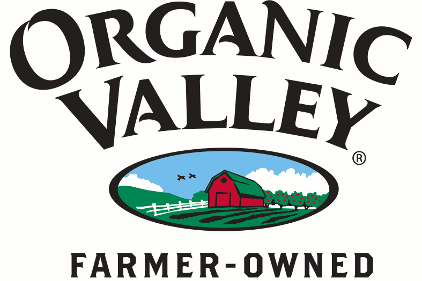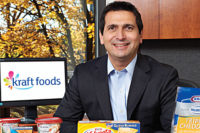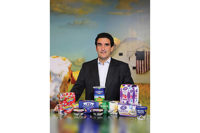Award-winning dairy processors
Organic Valley is the Dairy Foods Processor of the Year for 2010
Organic Valley has created a national organic brand of dairy foods, including milk, cheese, yogurt and butter. Owned by a cooperative of organic farmers, Organic Valley is the 2010 Processor of the Year.

Organic Valley, Processor of the Year
George Siemon, the chief executive officer of Organic Valley, likes words. The origin of “change,” he told Fast Company magazine, comes from the word for “kind of crooked.” It’s an apt word to describe the dairy products company. Change doesn’t happen in a straight line.
Organic Valley’s headquarters is in La Farge, Wis., which sits in the Kickapoo River valley. Coincidentally, “Kickapoo” is a Native American word meaning to go here and there, or crooked.
 The evolution of Organic Valley has followed a crooked path since its founding in 1988. A self-described lifelong naturalist, Siemon was one of seven Wisconsin farmers who formed a cooperative, which became known as the Cooperative Regions Of Organic Producer Pools, or CROPP, the owner of the Organic Valley brand. The members pledged to farm without antibiotics, synthetic hormones, pesticides or genetically modified organisms, and to pasture their animals. While they believed in sustainable agriculture, they were also seeking a way to save the small family farmer by paying a guaranteed price for their produce. A cooperative of organic farmers seemed to be the way to achieve that goal.
The evolution of Organic Valley has followed a crooked path since its founding in 1988. A self-described lifelong naturalist, Siemon was one of seven Wisconsin farmers who formed a cooperative, which became known as the Cooperative Regions Of Organic Producer Pools, or CROPP, the owner of the Organic Valley brand. The members pledged to farm without antibiotics, synthetic hormones, pesticides or genetically modified organisms, and to pasture their animals. While they believed in sustainable agriculture, they were also seeking a way to save the small family farmer by paying a guaranteed price for their produce. A cooperative of organic farmers seemed to be the way to achieve that goal.
CROPP’s first products were organically grown produce and meats, and it sells those items today. The first dairy product it made was cheese. Organic Valley has grown into a national marketer of organic milk, butter, yogurt, cream cheese, cottage cheese and soy beverages. Dairy is so dominant that it accounts for most of the co-op’s estimated $630 million sales this year.
 Despite a tough national economy, the company has grown its retail sales of dairy products, private-label products and exports. It launched new products and new marketing campaigns. The company has worked tirelessly to save the family farmer and to preserve rural communities.
Despite a tough national economy, the company has grown its retail sales of dairy products, private-label products and exports. It launched new products and new marketing campaigns. The company has worked tirelessly to save the family farmer and to preserve rural communities.
For these reasons, Organic Valley is Dairy Foods’ Processor of the Year for 2010.
CROPP is independent and farmer-owned, with 1,624 farmers in 34 states and four Canadian provinces. It is the largest cooperative of organic farmers in the United States and ranks 46th on Dairy Foods’ Dairy 100 list of largest processors.
Heading Organic Valley is Siemon, who also carries the whimsical title of “C-E-I-E-I-O.” (Everything at Organic Valley is carefully crafted to reinforce the company’s ties to farmers.) Siemon speaks thoughtfully and deliberately of words related to organics: organ, organism, organization. CROPP itself is an organ in a larger organization. Farmers take care of the earth through sound agricultural practices. The cooperative takes care of farmers by providing stable pricing. The products are sold to consumers seeking foods grown without pesticides and chemical fertilizers.

Omega-3 milks and drinkable yogurt
Milk is the company’s core product, with more than 90 SKUs of full-fat to fat-free dairy beverages, including omega-3, flavored, lactose-free, shelf-stable, non-homogenized, buttermilk, eggnog, cream and half-and-half.
New products this year are omega-3 milks with DHA, EPA and ALA. The whole milk and reduced-fat (2%) SKUs are sold as ultra-pasteurized in half-gallons and pasteurized in gallons. An 8-ounce serving contains 50 milligrams of EPA and DHA combined. The omega-3s are from sustainably harvested fish. The company says a glass features more supplemented omega-3s per serving than any other organic milk on the market.
That milk line is growing like “gangbusters,” says Eric C. Snowdeal III, the associate product manager for white milk and cream. Consumers like the health, nutrition and convenience found in the omega-3 milks, he says.
The other successful launch this year is a drinkable and pourable probiotic-cultured yogurt. The low-fat yogurt (in plain, vanilla and berry flavors) is sold in 32-ounce bottles. The company promotes the product for use on cereal, blending into smoothies, dips, marinades and dressings - or drinking straight from the bottle. The vanilla and berry yogurts are sweetened with organic agave nectar. Organic Valley promotes the sweetener’s low-glycemic index (17, compared to 65 for cane sugar).
In January 2011, Organic Valley will launch flavored, dairy-based half-and-half in vanilla and hazelnut flavors. The company also is developing organic soy-based nondairy creamers.
Organic Valley has found success with diversity, says Eric Newman, vice president of sales. That refers not only to its product offerings, but also to its channels of distribution. Of the estimated $630 million in sales this year, private-label business accounts for roughly $100 million. The ingredients division is a $50 million business. Organic Logistics, a wholly owned subsidiary for warehousing and transporting organic and natural foods, has annual sales of about $5 million.
Managing the private-label business is a bit of a balancing act because Organic Valley does not want to see its own brand suffer from store-brand sales of organic products.
“We churn more organic butter than anyone,” Newman says, adding that its branded sales of the product equal its private-label butter sales.
Exports are growing. Organic Valley does business in roughly 12 Asian countries. Mexico was a strong market until the country slapped tariffs on U.S. cheese imports this year in a Nafta-related dispute.
Newman said he wants to grow export sales of milk in asecptic packaging, and his eyes widen as he discusses the potential in China. Although Organic Valley has a program for foodservice operators, the institutional market is underdeveloped, Newman acknowledges.
Organic Valley is not in the ice cream business, and for now the company is sitting on the sidelines. In the ice cream category, “luxury” and “indulgence” are more important aspects than “organic,” as consumers stick with their favorite brands, Newman says. He adds that no national brand has been successful in marketing organic ice cream.

Producing and processing
Louise Hemstead, the company’s chief operating officer, introduces herself as a dairy farmer. She directs the operations of the company and develops the relationships with processors.
Although Organic Valley has a cheese conversion operation and still makes its own butter at a facility in Chaseburg, Wis., the co-op relies on a network of co-packers throughout the nation. CROPP works with 17 fluid-milk processors and 26 butter- and cheesemakers across the United States.
Getting to this level was not easy. Hemstead recalls the early days of trying to find processors to take the co-op’s milk. When her phone calls were not returned, she hit the road. She knocked on doors of milk processors and returned home with signed agreements. Over the years, the relationships have proved fruitful for all parties.
Hemstead lists the advantages to a co-packer of processing Organic Valley’s milk: it fills a plant’s unused capacity; it’s a known sale; and it can create long-term relationship. Siemon mentions that eventually CROPP will invest in processing plants, most likely by taking a minority interest rather than building new facilities.
The company shows its commitment to rural communities by maintaining a creamery in Chaseburg (population 308) and a distribution center in Cashton (1,062). Any talk of expanding includes discussion of small town locations.
CROPP entered into a long-term, financially beneficial relationship of its own this year when it began to manage about 270 organic milk contracts for Stonyfield Farm, Londonderry, N.H.
Processing partners are held to high standards
“We do quality really very well,” Hemstead says. The company performs 57 tests on fluid milk, from its raw state to the finished, packaged product. “Milk must be safe,” she says. “Everything starts with clean milk.” Organic Valley’s milk is the first milk of the day to be processed in a plant.
Asked about Organic Valley’s strength as an organization, Hemstead answers without hesitation. She cites communications with members, producing a quality product, marketing on a budget and supporting independent farmers and rural communities.
CROPP is “an interactive co-op,” Hemstead explains. Members have a voice in the running of the cooperative, and the management team listens. CROPP schedules twice-a-year, face-to-face meetings with members (before planting and after harvesting) at locations within one hour of their farms. The executive committee has a monthly two-hour teleconference with 70 farmers (elected by co-op members). Then there are regularly scheduled board of director meetings and the annual members’ meeting (held in nearby La Crosse). Through these interactions, farmers raise issues, share best farming practices and make decisions about company strategy and direction.
Spreading the word
As for marketing, Hemstead points to the company’s ability to create a national organic-milk brand with limited dollars. The website, word-of-mouth and guerrilla tactics all contribute to raising the profile of Organic Valley.
The company’s websites (for farmers and for consumers) are central to its success in marketing and communications, says Theresa Marquez, chief marketing executive. This year, the company updated the farmers.coop site for farmer members. The private, password-protected intranet site allows members to see their quality reports and to graph such factors as butterfat, protein, urea-nitrogen and somatic cell counts. Greg Brickl, the company’s interactive manager, calls the new site “a stunning success. The web is the focal point of everything we do.”
The home page of the consumer site (organicvalley.coop) also has been redesigned to allow for eight marquee spaces, enabling Organic Valley to appeal to its diverse consumers, which include mothers with young children, natural-food consumers and others interested in health, nutrition and organic products. The most prevalent demographic trait of the organic customer is having some college education.
On the consumer site, visitors gravitate to the home page, the coupons page and the “Who’s Your Farmer” section. This last section works hard to drive home the point that Organic Valley products do not come from an industrialized, factory operation. By entering a zip code, site visitors can find a nearby organic farm and read a profile of the farmer.
Marquez, a tireless supporter of organics, received the Organic Trade Association’s leadership award for growing the organic industry. Like everyone at Organic Valley, Marquez talks passionately about organic products and methods while being careful not to speak ill of conventionally produced milk.
This autumn, Organic Valley energized a new generation of organic farmers by taking a road trip in a vegetable-oil fueled bus to Midwest and East Coast colleges. Dubbed Generation Organic, the young farmers visited Oberlin, Harvard, Yale, Columbia and other universities at the invitation of campus environmental clubs. The farmers educated campus thought leaders about organic agricultural practices.
Running a cooperative the size of CROPP requires balancing the needs of sometime competing interests. Management has to be mindful of what its 1,600 co-op members want as well as what’s best for its 500 employees. Customers need to be nurtured and developed. Then there are the uncertainties of dairy farming itself, notes Jim Wedeberg, another founding co-op member. By tending to the details, planning for growth and reacting to unplanned events, the co-op has followed a crooked path that has led to success as a national dairy products marketer.
At a Glance: Cooperative Regions Of Organic Producer Pools
(owner of Organic Valley and Organic Prairie)
Headquarters: La Farge, Wis.
Founded: 1988
Employees: 545
Plant locations: Chaseburg, Wis. (creamery), Cashton, Wis. (distribution center). Organic Valley uses co-packers across the nation.
Products made: Organic milk, soy, cheese, butter, spreads, creams, yogurt, eggs, produce, juice and a full line of meats.
Annual sales: $630 million (2010, projected), $520 million (2009)
Corporate structure: Organic Valley represents more than 1,624 organic farmers in 34 states and four Canadian provinces. Members adhere to organic certification standards.
Looking for a reprint of this article?
From high-res PDFs to custom plaques, order your copy today!






